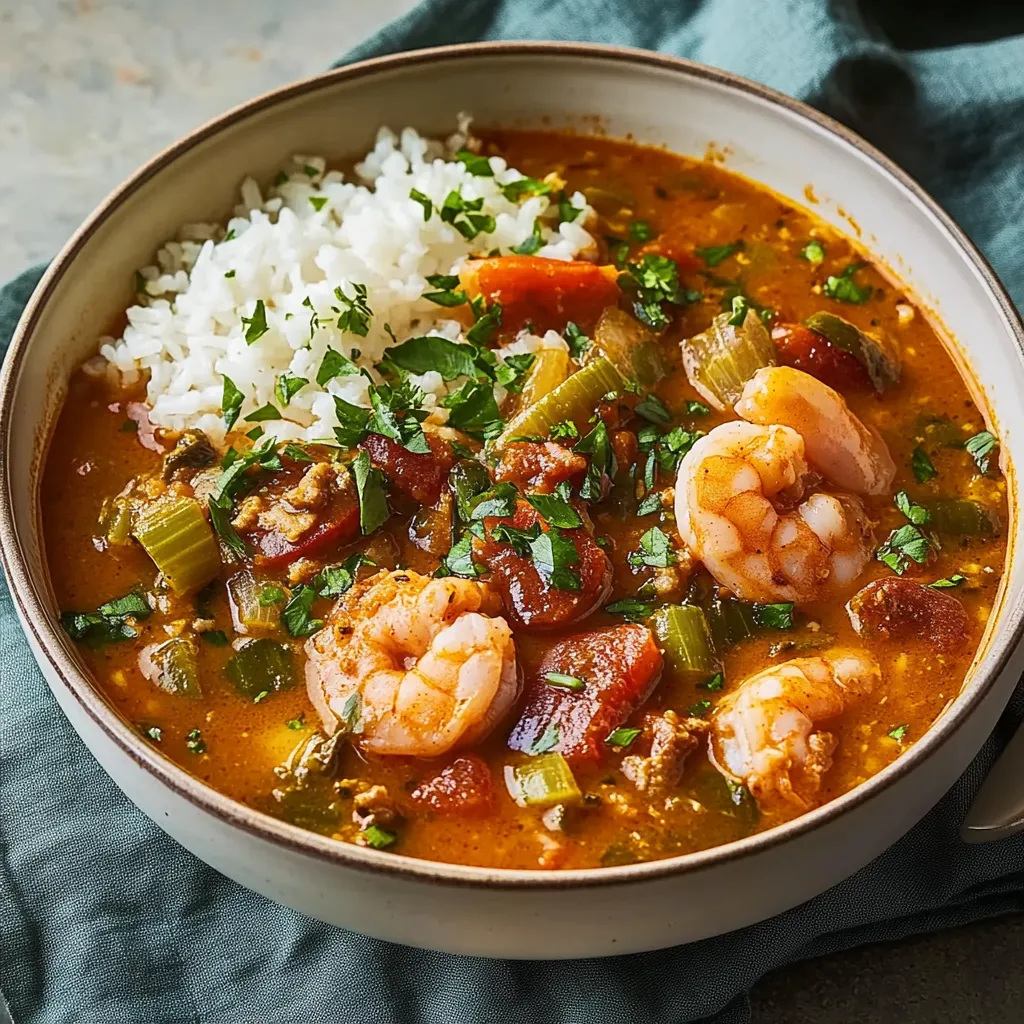 Pin it
Pin it
Down in New Orleans, gumbo isn't just food - it's a family story told through flavors that build one on top of another. This handed-down Creole dish starts with a deep, dark roux that sets the stage for everything else. When you mix that chocolate-colored base with fresh veggies, seafood, and spicy sausage, you get something that's fancy but comforting at the same time.
I first learned about this gumbo standing next to my grandma's stove. She always told me, "don't stop stirring, honey" while we watched the roux turn dark. I still hear those words whenever I cook this at home.
Key Ingredients Breakdown
- Bacon Drippings and Flour: Your roux starts here - grab regular white flour and strain your bacon fat so it's completely clear of bits. The quality of your bacon makes a big difference in the final taste
- Authentic Andouille: Look for real-deal andouille with a smoky smell and natural casing. This sausage sends its flavor through the whole pot as it cooks
- Fresh Veggie Mix: Get celery that snaps clean, bright onions, and thick-walled bell peppers. These three friends need to be at their best for proper flavor
Step-By-Step Cooking Guide
- Making Perfect Roux:
- Start with a heavy pot on medium-low. Let bacon fat warm completely. Add flour bit by bit while whisking. Keep moving in figure-eights nonstop. Watch as it changes from light tan to peanut butter color. Don't stop till it's rich brown (about 30 minutes). Keep whisking the whole time or you'll ruin it. Pull it off the heat when it looks like chocolate.
- Prepping The Veggie Base:
- Chop veggies into tiny, even bits. Don't turn them into mush. Put them in the hot roux carefully. Keep stirring so nothing sticks. They'll start to soften up. Let their sweetness come out naturally. Throw garlic in last few minutes. Cook until onions turn clear. Add just a tiny bit of salt.
- Creating Flavor Depth:
- Mix water and bouillon in another pot. Bring it to a light boil. Spoon roux mixture in slowly, one bit at a time. Stir well between each spoonful. Keep it just barely bubbling. Mix in spices a little at a time. Give bay leaves and thyme time to share their flavor. Tweak heat and seasonings as needed. Let it bubble for a full hour, stirring now and then.
- Fixing The Okra:
- Get bacon fat hot and shiny. Spread okra out in the pan. Don't pile it up. Pour vinegar on right away. Cook until it's not slimy anymore. Stir once in a while until edges get brown. Use a slotted spoon to add it to your gumbo. This trick keeps the slime out of your pot.
 Pin it
Pin it
My grandma always said making gumbo was like meditating - you can't rush and you can't walk away. I watched how she handled every ingredient with such care, and that showed me cooking isn't just about following recipes but showing love through what you make.
Perfectly Timed Seafood Addition
If you put seafood in too soon, it gets tough and chewy. Over the years, I've learned to put crab in first, then save the shrimp for the last few minutes of cooking, so everything stays just right.
 Pin it
Pin it
This gumbo has grown into something bigger than food in my family. It's now the thing that pulls everyone together. The smell fills up the house and brings folks into the kitchen to look in the pot and sneak tastes before dinner. These little moments mean as much as the meal itself. When I stir my pot now, I feel linked to all the New Orleans cooks before me who put this much care into their food.
Frequently Asked Questions
- → How do you make the roux right?
- You’ve gotta be patient! Stir the flour and drippings on medium-low heat for around 20-30 minutes. Keep whisking the whole time until it turns a deep brown. Don’t stop, or you might burn it!
- → Can I leave out filé powder?
- Filé adds a special taste and texture, but it’s fine to skip it. Okra’ll help thicken the gumbo, though the flavor will be a bit different.
- → How long does gumbo last in the fridge?
- It’ll keep for 3-4 days when refrigerated and up to six months in the freezer. Honestly, it tastes even better the day after you make it!
- → Can I swap out the seafood?
- Absolutely. Adjust based on what’s on hand—oysters, crawfish, or firm fish all work as substitutes for crab or shrimp.
- → Why split the filé powder stages?
- It helps balance the flavors during cooking and gives the right thickening effect at the end. Don't boil it after adding the final bit, though!
